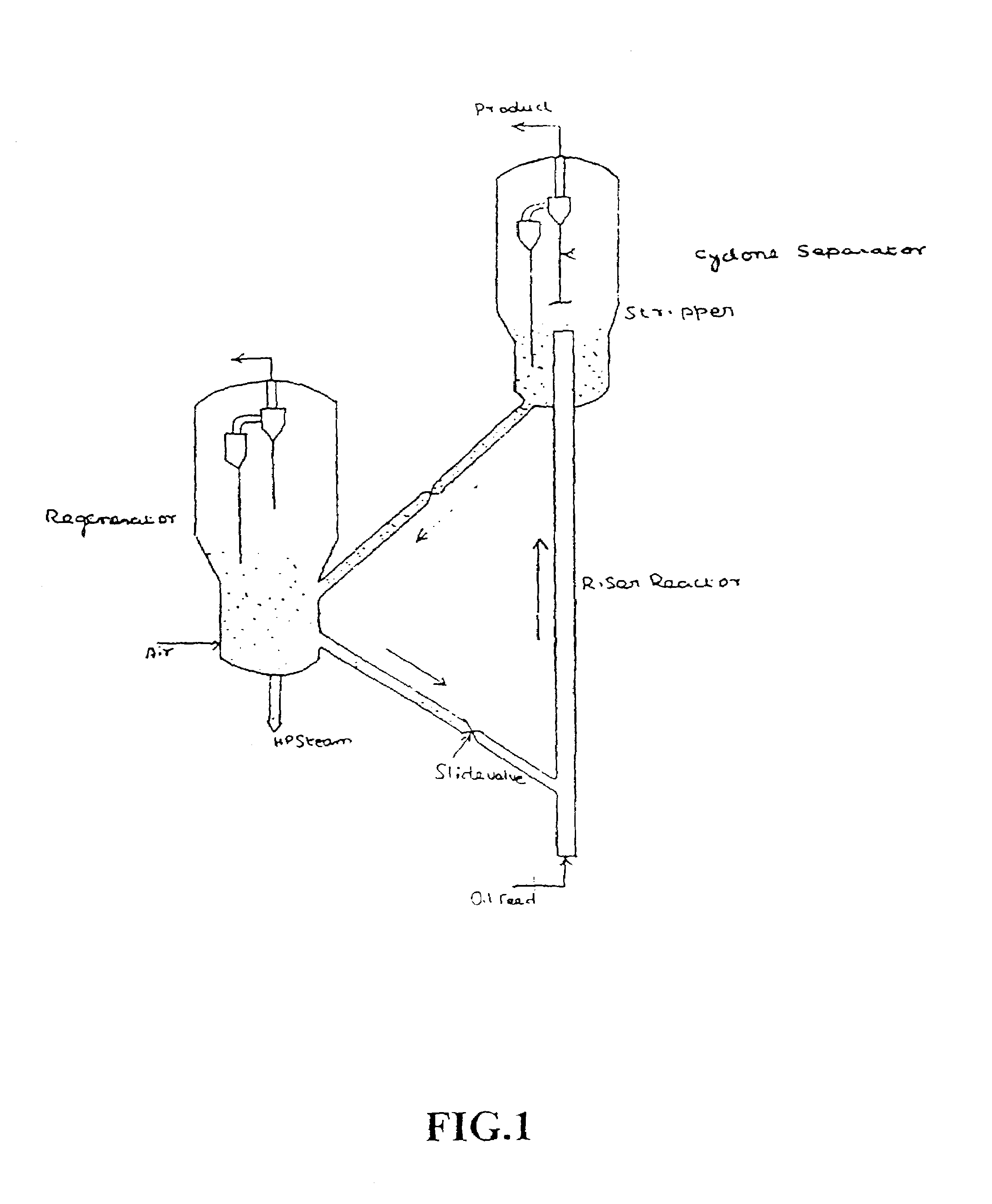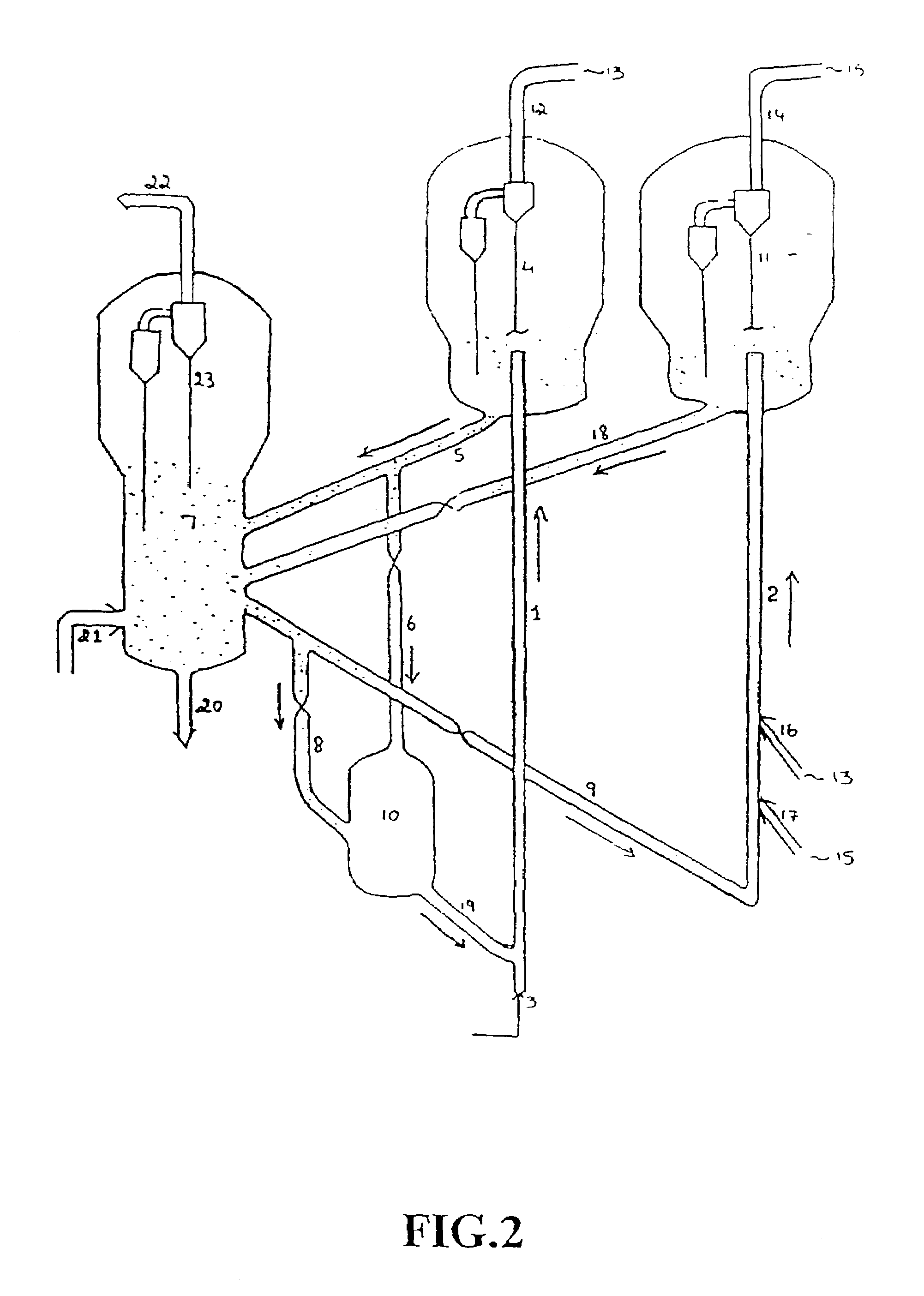Multi stage selective catalytic cracking process and a system for producing high yield of middle distillate products from heavy hydrocarbon feedstocks
a selective catalytic cracking and high yield technology, applied in catalytic cracking, hydrocarbon oil treatment, lighting and heating apparatus, etc., can solve the problems of high amount of recycle oil fed to the bottom of the riser with fresh feed, unconverted bottom yield increases to a significant extent, and reduces the throughput of the riser reactor. , the effect of improving the cetane quality of the middle distillate produ
- Summary
- Abstract
- Description
- Claims
- Application Information
AI Technical Summary
Benefits of technology
Problems solved by technology
Method used
Image
Examples
example-1 (
PRIOR ART)
Yield of Middle Distillate at Different Conversions in Conventional FCC Operation
[0076]This example illustrates the change in yield of the middle distillate product (TCO) at different conversion levels under conventional FCC conditions. −216° C. conversion is defined as the total quantity of products boiling below 216° C. including Coke. Similarly −370° C. conversion is defined as the total quantity of products boiling below 370° C. including Coke. The experiments were conducted in standard fixed bed Micro Activity Test (MAT) reactor described as per ASTM D-3907 with minor modifications indicated subsequently as modified MAT. The catalyst to be used is first steamed at 788° C. for 3 hours in presence of 100% steam. The physico-chemical properties of the feed used in the modified MAT reactor are given in the following Table-4 & 5.
[0077]
TABLE 4Density @ 15° C., gm / cc0.8953CCR, wt %0.32Sulfur, wt %1.12Basic Nitrogen, PPM366Paraffins, wt %44.4Naphthenes, wt %18.1Aromatics, wt ...
example-2
Effect of Reaction Temperature on Middle Distillate Yields at Same Conversion
[0083]This example illustrates the effect of reaction temperature on the yield of middle distillate at a given −216° C. conversion. The experiments were conducted in the modified MAT reactor with the same feed as mentioned in Example-1, at two different temperatures, viz., 425° C. and 495° C. Catalyst employed here is catalyst C which is commercially available FCC catalyst of following properties as shown in the Table-8.
[0084]
TABLE 8Catalyst-CSurface Area, m2 / gmFresh172Steamed119Pore volume, cc / gm0.32Crystallinity, %Fresh13.80Steamed10.20UCS ° AFresh24.55Steamed24.31Chemical Analysis, wt %RE2O30.69Al2O336.40Na2O0.11Particle size, micron / wt %−20 / −40 / −60 / −80 / −105 / −1203 / 16 / 32 / 56 / 77 / 86APS, micron76
[0085]
TABLE 9Temperature, ° C. II425495−216° C. conversion, wt %30503050W / F, Min.1.12.70.100.5Yield Pattern, wt %Dry gas0.200.420.380.56LPG4.109.15.0710.72Gasoline14.9423.5216.0024.58Heavy naphtha9.5014.277.1111.20LCO...
example-3
First Stage Riser Cracking Conditions
[0087]This example illustrates the significance of first stage riser cracking conditions, e.g., temperature, catalyst / oil ratio and conversion, on the yield of middle distillate and other products while employing commercially available FCC catalysts A and C, properties of which are described in Example-1 & 2 respectively. The tests were conducted in modified fixed bed MAT unit with same feed as described in Example-1. Yield data were generated at different conversion level for the catalysts as indicated above and the yields of different products were obtained. TCO / Rest ratios at different conversion levels are plotted in FIG.-3, from which it is observed that for both the catalysts, the TCO / Rest ratio increases as the −370° C. conversion is reduced. Therefore, it is important to note that the per pass −370° C. conversion in the first stage riser should be kept below about 45% and preferably below 40%.
[0088]From FIG.-3, it is also observed that th...
PUM
 Login to View More
Login to View More Abstract
Description
Claims
Application Information
 Login to View More
Login to View More - R&D
- Intellectual Property
- Life Sciences
- Materials
- Tech Scout
- Unparalleled Data Quality
- Higher Quality Content
- 60% Fewer Hallucinations
Browse by: Latest US Patents, China's latest patents, Technical Efficacy Thesaurus, Application Domain, Technology Topic, Popular Technical Reports.
© 2025 PatSnap. All rights reserved.Legal|Privacy policy|Modern Slavery Act Transparency Statement|Sitemap|About US| Contact US: help@patsnap.com



